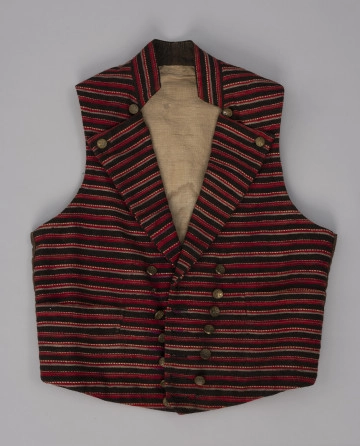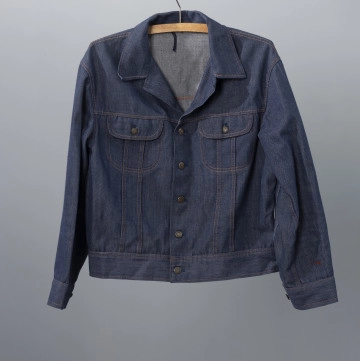
Men's waistcoat
1870 — 1920
National Museum in Szczecin
Part of the collection: Material culture of West Pomerania
Jamno, officially a district of Koszalin since 2010, was a village belonging to the city from the 13th century, but due to its location amidst marshland, it was geographically and culturally isolated until the end of the 19th century. The local population was involved in agriculture and fishing. In the first half of the 19th century, after the enfranchisement as a communal village, which could easily sell agricultural goods in the town, and owing to tax breaks, Jamno became the richest and most populous village in the vicinity of Koszalin. Economic development resulted in a prosperous living standards for the inhabitants: a construction boom, a wealth of furnishings, and flourishing of ornamentation. Both men's and women's clothing in their most opulent form developed around the middle of the 19th century, being a reflection of material status, to disappear in the early years of the 20th century, just as in other regions. Both were characterised by a significant proportion of homespun woollen fabrics, i.e. made at the farm on handlooms. They were woven in red, green, navy blue, white, and yellow stripes. An interesting element of men's clothing was a cap, in the style of a biretta, very rarely found in folk costumes. The Jamno garment was a combination of native and immigrant patterns - brought by colonists from the Netherlands and Germany. Probably modelled on the headgear of Lutheran clergymen, birettas were made of striped woollen fabric, just like the museum exhibit. Iwona Karwowska
Author / creator
Object type
biretta
Technique
twill weaving, weaving, hand sewing
Material
woolen homespun fabric, flax fabric
Origin / acquisition method
acquisition
Creation time / dating
Creation / finding place
Owner
Muzeum Narodowe w Szczecinie
Identification number
Location / status

nieznany
1870 — 1920
National Museum in Szczecin

unknown
circa 1650 — 1700
National Museum in Szczecin

Zakłady Przemysłu Odzieżowego ODRA, Szczecin (1964-2002)
1964 — 1989
National Museum in Szczecin
DISCOVER this TOPIC
National Museum in Lublin
DISCOVER this PATH
Educational path
0/500

We use cookies to make it easier for you to use our website and for statistical purposes. You can manage cookies by changing the settings of your web browser. More information in the Privacy Policy.
We use cookies to make it easier for you to use our website and for statistical purposes. You can manage cookies by changing the settings of your web browser. More information in the Privacy Policy.
Manage cookies:
This type of cookies is necessary for the website to function. You can change your browser settings to block them, but then the website will not work properly.
WYMAGANE
They are used to measure user engagement and generate statistics about the website to better understand how it is used. If you block this type of cookies, we will not be able to collect information about the use of the website and we will not be able to monitor its performance.